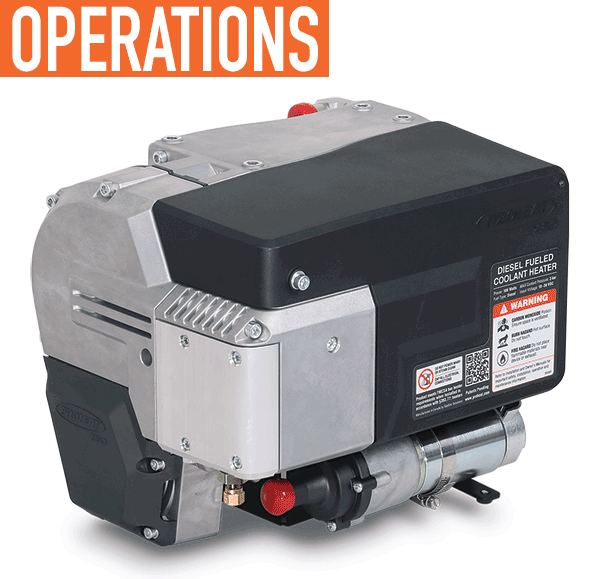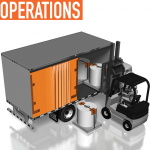It is not easy finding the right auxiliary heater for your work truck. There are almost as many considerations to keep in mind as there are options available on the market, and it isn’t always easy to get the information you need to make an informed choice that delivers a solid return on your investment. No single resource exists with details on the strengths and drawbacks of each option, and dealers typically specialize in just one brand, which means they may be misinformed or biased when detailing how one particular heater measures up against competing products.
UNEXPECTED COSTS
More pressing is the fact that it is often impossible to calculate the total cost of any heater, given the number of accessories available to choose from and the lifetime expenses you are likely to face. As a result, it is possible you could purchase a heater that seems very affordable based on sticker price but actually costs you more over the long run due to premature wear, breakdowns, and ongoing maintenance.
KEY FEATURES
Whatever your budget or requirements, there are certain key factors you should keep in mind when weighing auxiliary heater options for your work truck. The following checklist will help you make a selection that not only meets all of your heating and operational requirements but also delivers an exceptional return on investment:
Right size: A heater that is too small for your truck may work too hard to deliver the heat you need, leading to costly breakdowns and excessive wear. An oversized heater may cause short cycling and carbon buildup, which can result in frequent service expenses.
Robust design: The best way to maximize your return on investment is to choose an auxiliary heater that is built to last. Look for systems that that feature cast components, sealed electronics, and automotive grade connectors, as well as appropriate wire gauge. You should also look for a heater that can be serviced without having to remove it from your vehicle. Ask the dealer for full specs on any product they recommend, including data on its average lifespan and related maintenance costs.

Advanced technology: Features such as a modulating heat output and gear-drive fuel pumps help reduce scheduled maintenance of your auxiliary heater, not to mention costly equipment downtime.
Protection: Some heaters have built-in features that reduce the risk of system failure, such as a self-check during start-up, immediate alerts in the event of failed components or system error, and the ability to run system diagnostics using your computer. These features will alert you to any maintenance issues before they become expenses.
Support: Access to field service, service manuals, regular product updates, self-service training, and around-the-clock phone or online support all help to reduce the risk of costly downtime and service issues.
Installation cost: In some cases, you may be able to install your auxiliary heater using standard tools, but it may be more economical, not to mention safer, to have the dealer or a qualified installer do that for you.
Warranty: Your warranty should cover the heater, and all parts and labor, for at least two years. Keep in mind that some warranties have limits based on hours or only cover a specific time period. Be sure to ask the dealer if the warranty goes into effect on the day of purchase or at the time the heater is put in service.

Lifespan: The heater you choose for your work truck should last for the life of your vehicle, or longer. Occasionally, you may need to replace some parts due to wear and tear, but these costs typically will not exceed the value of the heater. Ask your dealer for details on the average lifespan of their auxiliary heaters.
Maintenance: A reliable heater should not require major service more than once a year. Annual checks will help identify any possible service issues and ensure fuel and air filters are changed before they pose problems.
Benefits: Auxiliary heaters deliver many benefits for the safe operation of your work truck. For example, they provide engine preheat that enables easier start up in cold climates, but there are also compelling reasons to install and use them in more moderate climates or temperatures. Engines tend to produce higher emissions until they reach full operating temperature, thus preheating the engine with an auxiliary heater reduces both warm-up time and particulates. This helps extend the life of your engine while also protecting the environment. Ask your dealer for more details on the benefits and features of their auxiliary heaters.
These are just a few of the many factors you should keep in mind when buying your next auxiliary heater. The more informed you are about the different options on the market, the easier it will be to find an auxiliary heater that delivers long-term benefits, a solid return on investment, and the heat you and your passengers want, when you want it.
Ultimately, that is the type of system that offers the most significant benefit of all: Making you feel warm inside.
FOR MORE INFORMATION:
Find out more about selecting the right auxiliary heater for your work truck, visit www.proheatbuyersguide.com.
_______________________________________________________________________
MODERN WORKTRUCK SOLUTIONS: OCTOBER 2017 ISSUE
Did you enjoy this article?
Subscribe to the FREE Digital Edition of Modern WorkTruck Solutions magazine.
![]()




